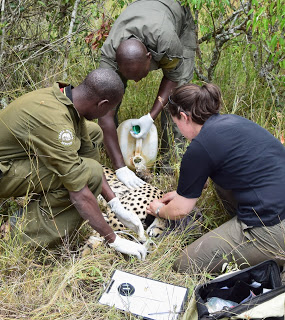My research focuses on how African wild dogs and cheetah live in a human-dominated landscape in Laikipia County in Northern Kenya, and how geographical features such as fences affect them. Both wild dogs and cheetah have suffered from extensive habitat loss and fragmentation across Africa, with wild dogs now found in just 7% of their former range and cheetah 11%. They are the widest-ranging species within the African large carnivore guild; with individuals and groups from both species having been recorded having home-ranges of more than 2000 sq km. This wanderlust means they need large areas of carnivore-friendly land to survive. As with European carnivore populations, very few protected areas are large enough to support viable populations of cheetah or wild dogs on their own, meaning that habitat loss and fragmentation are still very real threats to their survival. When you talk about habitat loss and fragmentation people's first thoughts are usually of vast swathes of tropical forests being cut down, leaving only small stands of trees, however such images don’t tell the full story. Fragmentation is caused by any feature that prevents animals moving from one area of habitat to another. Increases in fragmentation mean that connections between habitat patches are lost and can result in serious consequences for the species affected, ranging from animals no longer having access to the resources they need to survive or, in the longer-term, inbreeding.
For many human-dominated landscapes amongst the key causes of fragmentation are fences. This kind of fragmentation is much less obvious than a vast swathe of deforestation as there may well be areas of apparently prime habitat on each side of the fence. Nonetheless fences can have important impacts on the connectivity of an area - after all preventing movement between different areas is literally their raison d'etre.
In order to look at how wild dogs and cheetah live in and move through their landscape, I use data collected by GPS collars, which my colleagues and I fit to our study animals. These collars record the animal’s location at pre-programmed times throughout the day, enabling me to see how they interact with different features within the landscape. It is perhaps not surprising that I have found that fences have important impacts on our study animals but what has been interesting is the extent to which the design of the fence affects how much the wild dogs and cheetah are affected by them. Whilst some fences have significant effects, others appear to have little or no effect at all.
Laikipia is an area of huge conservation significance. Living alongside a large and growing human population there are high wildlife densities and vital populations of several globally threatened species. Laikipia is already a human-dominated landscape and is only likely to become more so over the coming years. However, whilst it is undoubtedly important to take into account the effects of different socio-economic and cultural factors, it is nevertheless encouraging to look to carnivore populations throughout the European mainland and see them persisting, and even thriving, in human-dominated landscapes there. The recent increases in European carnivore populations can largely be attributed to protective legislation and general public support of carnivore conservation, and whilst the on-the-ground approach would need to be implemented in a culturally appropriate and sensitive manner, the success in Europe can nevertheless provide insight into effective methods for carnivore conservation in Africa. Sharing a landscape with large carnivores is undeniably challenging – they are not always the easiest of neighbours – but the resurgence of European large carnivore populations shows that it is possible. Helen O'Neill is a PhD candidate at Zoological Society London, and her research focuses on cheetah and African wild dogs living in a human-dominated landscape in Northern Kenya. You can find more about her research here or reach out to her on Twitter @hmk_oneill. |
Studying and Saving Species in the Anthropocene
The world is changing. Areas that were once remote are becoming ever more accessible; even the world’s few remaining areas of wilderness are increasingly human-dominated. The global human population’s ever growing effects on the environment has led many people to start referring to our current period in history as the Anthropocene.
Habitat loss and fragmentation are the leading threats to global biodiversity. As areas where wild species once thrived disappear and remaining parcels of wilderness become rarer and more isolated, wildlife is often forced into closer contact with local human populations. Whilst protected areas are undoubtedly important refuges for many threatened species, human-dominated landscapes are nevertheless likely to be key for the future of conservation.
Large carnivore populations in Europe provide tangible evidence of the importance of human-dominated landscapes to conservation. Just a few decades ago, across the continent populations of brown bears (Ursus arctos), grey wolves (Canis lupus) and Eurasian lynx (Lynx lynx) had undergone massive declines as a result of habitat loss in combination with human persecution. However, over recent years these carnivore populations have had a resurgence. Changes in legislation providing the species with greater protection from persecution, along with the establishment of nature reserves, has led to populations of all three species remaining steady and even increasing across Europe. Whilst the increase in protected areas has been of great importance for these carnivore species, the majority of their populations still live outside of protected areas. It is likely thanks to the recognition of the importance of these non-protected, and human-dominated areas to carnivore conservation and the interventions that have focused on them, which has resulted in carnivore population recoveries.
